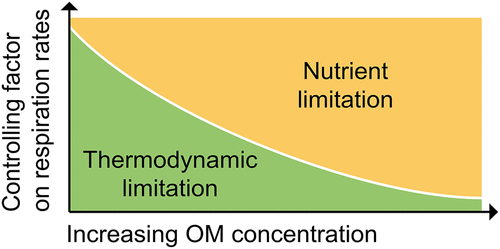当前位置:
X-MOL 学术
›
Environ. Sci. Technol. Lett.
›
论文详情
Our official English website, www.x-mol.net, welcomes your
feedback! (Note: you will need to create a separate account there.)
Carbon Limitation Leads to Thermodynamic Regulation of Aerobic Metabolism
Environmental Science & Technology Letters ( IF 8.9 ) Pub Date : 2020-05-15 , DOI: 10.1021/acs.estlett.0c00258 Vanessa A. Garayburu-Caruso 1 , James C. Stegen 1 , Hyun-Seob Song 1, 2 , Lupita Renteria 1 , Jaqueline Wells 1, 3 , Whitney Garcia 1 , Charles T. Resch 1 , Amy E. Goldman 1 , Rosalie K. Chu 4 , Jason Toyoda 4 , Emily B. Graham 1
Environmental Science & Technology Letters ( IF 8.9 ) Pub Date : 2020-05-15 , DOI: 10.1021/acs.estlett.0c00258 Vanessa A. Garayburu-Caruso 1 , James C. Stegen 1 , Hyun-Seob Song 1, 2 , Lupita Renteria 1 , Jaqueline Wells 1, 3 , Whitney Garcia 1 , Charles T. Resch 1 , Amy E. Goldman 1 , Rosalie K. Chu 4 , Jason Toyoda 4 , Emily B. Graham 1
Affiliation

|
Organic matter (OM) metabolism in freshwater ecosystems is a critical source of uncertainty in global biogeochemical cycles, yet the processes regulating aerobic respiration in aquatic environments remain poorly understood. Aerobic respiration is typically predicted through kinetic controls such as organic carbon and oxygen concentrations, while assuming thermodynamic regulation has no influence. The role of OM thermodynamics has been mainly explored under anaerobic conditions; however, recent observations have suggested that thermodynamic properties of OM may influence aerobic respiration rates. Here, we explicitly test OM thermodynamics as a key regulator of aerobic respiration. We pair controlled microcosm experiments with ultrahigh-resolution OM characterization to show that aerobic respiration increases with OM thermodynamic favorability under carbon limitation. We also demonstrate a shift in the regulation of aerobic respiration from OM thermodynamics to nitrogen content when carbon is in excess, highlighting a central role for OM thermodynamics particularly in carbon-limited ecosystems. This illuminates a structural gap in aquatic biogeochemical models by demonstrating that both kinetic and thermodynamic constraints can modulate aerobic respiration. Our work therefore proposes a new conceptual model in which thermodynamic and nutrient limitations dually control aerobic respiration.
中文翻译:

碳限制导致有氧代谢的热力学调节
淡水生态系统中的有机物(OM)代谢是全球生物地球化学循环中不确定性的重要来源,但是在水生环境中调节有氧呼吸的过程仍然知之甚少。通常通过动力学控制(例如有机碳和氧气浓度)来预测有氧呼吸,而假设热力学调节没有影响。OM热力学的作用主要是在厌氧条件下进行的。然而,最近的观察表明,OM的热力学性质可能影响有氧呼吸速率。在这里,我们明确测试OM热力学作为有氧呼吸的关键调节器。我们将可控缩影实验与超高分辨率OM表征配对,以表明在碳限制下,有氧呼吸随着OM热力学适应性的增加而增加。当碳过量时,我们还证明了有氧呼吸的调节从OM热力学转变为氮含量,突出了OM热力学的核心作用,特别是在碳限制的生态系统中。通过证明动力学和热力学约束都可以调节有氧呼吸,从而阐明了水生生物地球化学模型中的结构缺口。因此,我们的工作提出了一个新的概念模型,其中热力学和营养限制双重控制了有氧呼吸。当碳过量时,我们还证明了有氧呼吸的调节从OM热力学转变为氮含量,突出了OM热力学的核心作用,特别是在碳限制的生态系统中。通过证明动力学和热力学约束都可以调节有氧呼吸,从而阐明了水生生物地球化学模型中的结构缺口。因此,我们的工作提出了一个新的概念模型,其中热力学和营养限制双重控制了有氧呼吸。当碳过量时,我们还证明了有氧呼吸的调节从OM热力学转变为氮含量,突出了OM热力学的核心作用,特别是在碳限制的生态系统中。通过证明动力学和热力学约束都可以调节有氧呼吸,从而阐明了水生生物地球化学模型中的结构缺口。因此,我们的工作提出了一个新的概念模型,其中热力学和营养限制双重控制了有氧呼吸。
更新日期:2020-07-14
中文翻译:

碳限制导致有氧代谢的热力学调节
淡水生态系统中的有机物(OM)代谢是全球生物地球化学循环中不确定性的重要来源,但是在水生环境中调节有氧呼吸的过程仍然知之甚少。通常通过动力学控制(例如有机碳和氧气浓度)来预测有氧呼吸,而假设热力学调节没有影响。OM热力学的作用主要是在厌氧条件下进行的。然而,最近的观察表明,OM的热力学性质可能影响有氧呼吸速率。在这里,我们明确测试OM热力学作为有氧呼吸的关键调节器。我们将可控缩影实验与超高分辨率OM表征配对,以表明在碳限制下,有氧呼吸随着OM热力学适应性的增加而增加。当碳过量时,我们还证明了有氧呼吸的调节从OM热力学转变为氮含量,突出了OM热力学的核心作用,特别是在碳限制的生态系统中。通过证明动力学和热力学约束都可以调节有氧呼吸,从而阐明了水生生物地球化学模型中的结构缺口。因此,我们的工作提出了一个新的概念模型,其中热力学和营养限制双重控制了有氧呼吸。当碳过量时,我们还证明了有氧呼吸的调节从OM热力学转变为氮含量,突出了OM热力学的核心作用,特别是在碳限制的生态系统中。通过证明动力学和热力学约束都可以调节有氧呼吸,从而阐明了水生生物地球化学模型中的结构缺口。因此,我们的工作提出了一个新的概念模型,其中热力学和营养限制双重控制了有氧呼吸。当碳过量时,我们还证明了有氧呼吸的调节从OM热力学转变为氮含量,突出了OM热力学的核心作用,特别是在碳限制的生态系统中。通过证明动力学和热力学约束都可以调节有氧呼吸,从而阐明了水生生物地球化学模型中的结构缺口。因此,我们的工作提出了一个新的概念模型,其中热力学和营养限制双重控制了有氧呼吸。











































 京公网安备 11010802027423号
京公网安备 11010802027423号